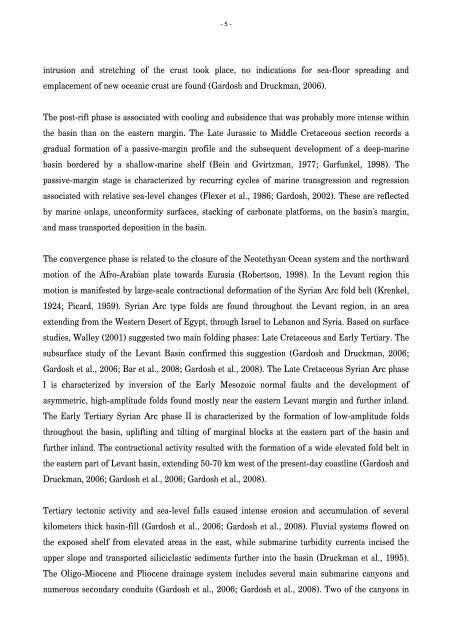The Oligo-Miocene deepwater system of the Levant Basin
The Oligo-Miocene deepwater system of the Levant Basin
The Oligo-Miocene deepwater system of the Levant Basin
Create successful ePaper yourself
Turn your PDF publications into a flip-book with our unique Google optimized e-Paper software.
- 5 -intrusion and stretching <strong>of</strong> <strong>the</strong> crust took place, no indications for sea-floor spreading andemplacement <strong>of</strong> new oceanic crust are found (Gardosh and Druckman, 2006).<strong>The</strong> post-rift phase is associated with cooling and subsidence that was probably more intense within<strong>the</strong> basin than on <strong>the</strong> eastern margin. <strong>The</strong> Late Jurassic to Middle Cretaceous section records agradual formation <strong>of</strong> a passive-margin pr<strong>of</strong>ile and <strong>the</strong> subsequent development <strong>of</strong> a deep-marinebasin bordered by a shallow-marine shelf (Bein and Gvirtzman, 1977; Garfunkel, 1998). <strong>The</strong>passive-margin stage is characterized by recurring cycles <strong>of</strong> marine transgression and regressionassociated with relative sea-level changes (Flexer et al., 1986; Gardosh, 2002). <strong>The</strong>se are reflectedby marine onlaps, unconformity surfaces, stacking <strong>of</strong> carbonate platforms, on <strong>the</strong> basin's margin,and mass transported deposition in <strong>the</strong> basin.<strong>The</strong> convergence phase is related to <strong>the</strong> closure <strong>of</strong> <strong>the</strong> Neotethyan Ocean <strong>system</strong> and <strong>the</strong> northwardmotion <strong>of</strong> <strong>the</strong> Afro-Arabian plate towards Eurasia (Robertson, 1998). In <strong>the</strong> <strong>Levant</strong> region thismotion is manifested by large-scale contractional deformation <strong>of</strong> <strong>the</strong> Syrian Arc fold belt (Krenkel,1924; Picard, 1959). Syrian Arc type folds are found throughout <strong>the</strong> <strong>Levant</strong> region, in an areaextending from <strong>the</strong> Western Desert <strong>of</strong> Egypt, through Israel to Lebanon and Syria. Based on surfacestudies, Walley (2001) suggested two main folding phases: Late Cretaceous and Early Tertiary. <strong>The</strong>subsurface study <strong>of</strong> <strong>the</strong> <strong>Levant</strong> <strong>Basin</strong> confirmed this suggestion (Gardosh and Druckman, 2006;Gardosh et al., 2006; Bar et al., 2008; Gardosh et al., 2008). <strong>The</strong> Late Cretaceous Syrian Arc phaseI is characterized by inversion <strong>of</strong> <strong>the</strong> Early Mesozoic normal faults and <strong>the</strong> development <strong>of</strong>asymmetric, high-amplitude folds found mostly near <strong>the</strong> eastern <strong>Levant</strong> margin and fur<strong>the</strong>r inland.<strong>The</strong> Early Tertiary Syrian Arc phase II is characterized by <strong>the</strong> formation <strong>of</strong> low-amplitude foldsthroughout <strong>the</strong> basin, uplifting and tilting <strong>of</strong> marginal blocks at <strong>the</strong> eastern part <strong>of</strong> <strong>the</strong> basin andfur<strong>the</strong>r inland. <strong>The</strong> contractional activity resulted with <strong>the</strong> formation <strong>of</strong> a wide elevated fold belt in<strong>the</strong> eastern part <strong>of</strong> <strong>Levant</strong> basin, extending 50-70 km west <strong>of</strong> <strong>the</strong> present-day coastline (Gardosh andDruckman, 2006; Gardosh et al., 2006; Gardosh et al., 2008).Tertiary tectonic activity and sea-level falls caused intense erosion and accumulation <strong>of</strong> severalkilometers thick basin-fill (Gardosh et al., 2006; Gardosh et al., 2008). Fluvial <strong>system</strong>s flowed on<strong>the</strong> exposed shelf from elevated areas in <strong>the</strong> east, while submarine turbidity currents incised <strong>the</strong>upper slope and transported siliciclastic sediments fur<strong>the</strong>r into <strong>the</strong> basin (Druckman et al., 1995).<strong>The</strong> <strong>Oligo</strong>-<strong>Miocene</strong> and Pliocene drainage <strong>system</strong> includes several main submarine canyons andnumerous secondary conduits (Gardosh et al., 2006; Gardosh et al., 2008). Two <strong>of</strong> <strong>the</strong> canyons in
















